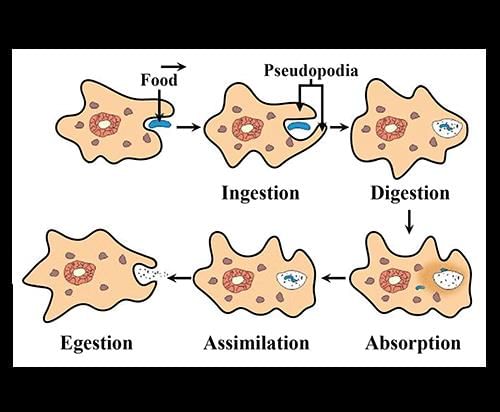Class 10 Exam > Class 10 Questions > Explain nutrition in unicellular eukaryotic o...
Start Learning for Free
Explain nutrition in unicellular eukaryotic organism (amoeba) with diagram?
Most Upvoted Answer
Explain nutrition in unicellular eukaryotic organism (amoeba) with dia...
Nutrition in Unicellular Eukaryotic Organism (Amoeba)
Introduction
Amoeba is a unicellular eukaryotic organism that belongs to the kingdom Protista. It is a microscopic organism that lives in freshwater and feeds on other microorganisms. The process of obtaining food in amoebae is known as nutrition.
Modes of Nutrition
Amoebae can obtain their food in two ways:
- Autotrophic mode of nutrition
- Heterotrophic mode of nutrition
Autotrophic Mode of Nutrition
Autotrophic amoebae are capable of producing their own food through photosynthesis. They contain chloroplasts which help in the process of photosynthesis. However, this type of amoeba is very rare.
Heterotrophic Mode of Nutrition
Most amoebae obtain their food through the process of phagocytosis. They engulf their food by extending their pseudopodia around the food particle and enclosing it in a food vacuole. The food vacuole then fuses with lysosomes, and the food is broken down into simpler substances.
Digestion in Amoeba
The process of digestion in amoeba occurs in the food vacuoles. The food vacuole contains enzymes that break down the food into simpler substances. The digested food is then absorbed by the cytoplasm and used for various metabolic activities.
Excretion in Amoeba
The process of excretion in amoeba occurs through the contractile vacuoles. The contractile vacuoles help in removing excess water and waste materials from the cell.
Conclusion
In conclusion, amoebae obtain their food through the process of phagocytosis and digest it in the food vacuoles. The digested food is then absorbed by the cytoplasm and used for various metabolic activities. The process of excretion occurs through the contractile vacuoles.
Community Answer
Explain nutrition in unicellular eukaryotic organism (amoeba) with dia...
. Nutrition on Amoeba:
Amoeba is a unicellular organism, which follows the holozoic mode of nutrition.
The process of obtaining food is called phagocytosis.
The various processes involved in nutrition are ingestion, digestion, absorption, assimilation and egestion.
Ingestion is the process by which the food is taken in
by forming finger-like projections called pseudopodia and the food is engulfed forming a vacuole.
Digestion is the process wherein the food is broken down into simpler substances in the vacuole, with the help of digestive enzymes.
Absorption is the process by which the digested food in the vacuole is absorbed into the cytoplasm by diffusion.
Assimilation is the process where a part of the food that is absorbed into the cytoplasm is used to generate energy.
Egestion is the process wherein the undigested food is thrown out of the body from the vacuole.

Attention Class 10 Students!
To make sure you are not studying endlessly, EduRev has designed Class 10 study material, with Structured Courses, Videos, & Test Series. Plus get personalized analysis, doubt solving and improvement plans to achieve a great score in Class 10.

|
Explore Courses for Class 10 exam
|

|
Similar Class 10 Doubts
Explain nutrition in unicellular eukaryotic organism (amoeba) with diagram?
Question Description
Explain nutrition in unicellular eukaryotic organism (amoeba) with diagram? for Class 10 2024 is part of Class 10 preparation. The Question and answers have been prepared according to the Class 10 exam syllabus. Information about Explain nutrition in unicellular eukaryotic organism (amoeba) with diagram? covers all topics & solutions for Class 10 2024 Exam. Find important definitions, questions, meanings, examples, exercises and tests below for Explain nutrition in unicellular eukaryotic organism (amoeba) with diagram?.
Explain nutrition in unicellular eukaryotic organism (amoeba) with diagram? for Class 10 2024 is part of Class 10 preparation. The Question and answers have been prepared according to the Class 10 exam syllabus. Information about Explain nutrition in unicellular eukaryotic organism (amoeba) with diagram? covers all topics & solutions for Class 10 2024 Exam. Find important definitions, questions, meanings, examples, exercises and tests below for Explain nutrition in unicellular eukaryotic organism (amoeba) with diagram?.
Solutions for Explain nutrition in unicellular eukaryotic organism (amoeba) with diagram? in English & in Hindi are available as part of our courses for Class 10.
Download more important topics, notes, lectures and mock test series for Class 10 Exam by signing up for free.
Here you can find the meaning of Explain nutrition in unicellular eukaryotic organism (amoeba) with diagram? defined & explained in the simplest way possible. Besides giving the explanation of
Explain nutrition in unicellular eukaryotic organism (amoeba) with diagram?, a detailed solution for Explain nutrition in unicellular eukaryotic organism (amoeba) with diagram? has been provided alongside types of Explain nutrition in unicellular eukaryotic organism (amoeba) with diagram? theory, EduRev gives you an
ample number of questions to practice Explain nutrition in unicellular eukaryotic organism (amoeba) with diagram? tests, examples and also practice Class 10 tests.

|
Explore Courses for Class 10 exam
|

|
Suggested Free Tests
Signup for Free!
Signup to see your scores go up within 7 days! Learn & Practice with 1000+ FREE Notes, Videos & Tests.

























